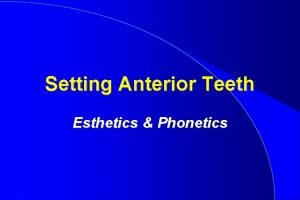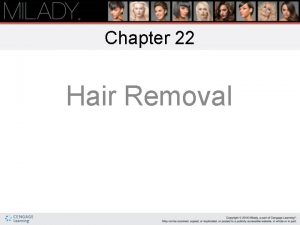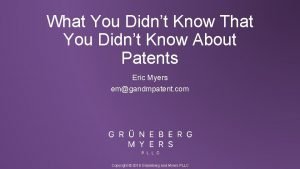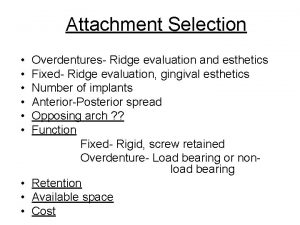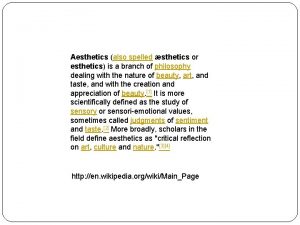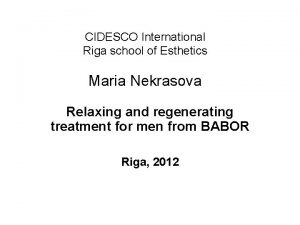Surface Medical Esthetics PLLC Kathleen Connolly Grand Canyon




















- Slides: 20

Surface Medical Esthetics, PLLC Kathleen Connolly Grand Canyon University October 9, 2013

The Art & Science Of Botulinum Toxin A & Dermal Filler Implantation �Baby Boomers (people born between 1946 -1964) are reaching middle age �Unlike other populations, they refuse to let the aging process define them �Physical appearance is very important to many people in this population �People are now more open about cosmetic procedures �The stigma associated with cosmetic procedures has decreased greatly �People want to look and feel more youthful

Treatment Options �There are 7 serologically different neurotoxins produced by Clostridium Botulinum bacteria (A, B, C, D, E, F & G). �Botulinum Toxin Type A = Most potent. �Only Botulinum A & B are available for clinical use �FDA Approved on April 15, 2002 for moderate-severe horizontal forehead lines, glabellar, and eye areas (crow’s feet).

Top Six Most Popular Cosmetic Non-surgical Procedures, 2008 � 1. ) Botox � 2. ) Dermal Fillers � 3. ) Chemical Peels � 4. ) Laser Hair Removal � 5. ) Microdermabrasion � 6. ) Vein Treatments 5, 014, 446 2, 703, 005 1, 048, 577 891, 712 841, 733 375, 328

Botulinum Type A �A Highly refined purified protein �Absolutely no live bacteria �The injection can not give you an infection (such as botulism) �The toxin blocks the nerve impulse that controls muscle movement �Restricts the patient’s ability to contract the facial muscles �No contraction= no movement= no wrinkles! �Results typically last 3 -6 months

Mechanism Of Action �Creates a paralyzing effect �Botulinum Toxin A actually effects the nerves, not the muscles �Botulinum Toxin A prevents the release of acetylcholine �The muscle itself is not altered �Does not alter sensory nerves �Therefore, it does not make the skin numb �Once the product wears off, wrinkles return, but are not any worse than before the treatment.

Common Areas Treated �Used in the treatment of facial lines that result form a pull for the muscles from expression �Known as dynamic wrinkles (wrinkles in motion) �Successful in treating the upper third portion of the face �Primary areas: Glabellar (frown lines between the eyebrows), horizontal forehead lines, and the Lateral Canthal areas (crow’s feet /outer eye areas ). �Also used for treatment of migraine or tension headaches (relaxes muscle tension)

Some Possible Side Effects: �Ecchymosis: associated with any type of injection �Transient headaches �Swelling �Pain �Edema at injection site �Infection �Rhinitis �Nausea �Muscle weakness �Hypertension �Flu-like symptoms �Diplopia, Double vision, and Lip Ptosis

Contraindications � Dermatitis or infection at site to be treated � Marked Facial Asymmetry (i. e. Bells Palsy) � Deep Dermal Scarring � Severe Anxiety related to needle pain � Currently using antibiotics and /or aminoglycosides � Natural eyelid Ptosis (present with a non-arched eyebrow) � Patients who have undergone facial surgery, recent blepharoplasty or CO 2 laser resurfacing � Pregnant and /or Lactating women � Hypersensitivity to any ingredient in Albumin (human blood product) � Neurologic Disorders ( Myasthenia Gravis, Parkinson’s Disease, Multiple Sclerosis) � Fever, Flu, or Cold symptoms

Soft Tissue Augmentation Dermal Fillers �Fillers can be classified into two main categories: � 1. ) Permanent � 2. ) Non-permanent �Other classifications include: � 1. ) Biodegradable or non-biogradegradable � 2. ) Animal or non-animal � 3. ) autologous or non-autologous

Permanent Filler Products �Artefill (Artecoll): Approved in 2007, and contains Bovine Collagen �Silicone (Silikon 1000) FDA approved for Ophthalmology �Biopolymers , Silica based (not available in the US)

Common Temporary Filler Products �Juvederm Ultra: FDA approved in 2007 �Restylane: Approved by the FDA: December, 2003 �Perlane: Approved by the FDA: May, 2007 � These are all hyaluronic acids: they are degradable and dissipate over time. They are non-animal based, no skin testing required.

Precautions �Caution should be used with: � Patients on immunosuppressive therapy � Patients on Nsaids and /or Aspirin �Hypersensitive patients �Patients who have recently had overexposure to UV rays

Contraindications �In patients with severe allergies and a history of anaphylaxis �Patients who are allergic to gram positive bacterial proteins �Should not be injected into a blood vessel �Patients with known susceptibility to keloid formation or hypertrophic scarring �Pregnant or Lactating women

Possible Side Effects �Hyaluronic Acid based products (Juvedrem, Resrylane, Perlane) can cause: �Erythema �Swelling �Mild pain /discomfort �Itching �Discoloration �Tenderness �Pruritis �Nodules

The Consultation �Individual Facial analysis �Listen to what the patient is unhappy about (with their appearance) �Obtain a medical history �Timing of treatment �Assess the patient’s need for pain management �Communicate that tough-ups made be needed �Cost of treatment �Realistic results of the treatment �Before and after photos �Obtain an Informed Consent

What Can Fillers Do? � 1. ) Fill in lines (smile lines, nasolabial folds, perioral lines, marionette lines. � 2. ) Fill in scars � 3. ) Restore the contours of the lips � 4. ) Add fullness to the face (cheeks, cheekbones, lips. Chin, above the eyebrows, under the eyes)

Talk to your health care professional about…… �The various options �Determine what facial areas you may want to enhance �Your health history �Risks and benefits of various treatment options �Prior treatments and procedures

Any Questions? ? ?

References � Dover, J. S. (2005). Clinical use of Restylane. Skin Therapy Letter. 10 (1): 5 -7 Retrieved from: http//www. medscape. com/viewarticle/500823 � Parker, S. (2008). The Art and Science of Dermal Filler Implantation. Esthetic Skin Institute. Ft. Lauderdale, FL � Parker, S. (2008). The Art and Science of Botulinum Toxin A. Esthetic Skin Institute. Ft. Lauderdale, FL. Vartanian, J. , Frankel, A. , & Rubin, M. (2008). Injected Hyaluronidase Reduces Restylane-Mediated Cutaneous Augmentation. ARCH Facial Plastic Surgery Vol 7, pgs. 231 -237
 Phonetic symmetry
Phonetic symmetry Milady chapter 22 hair removal
Milady chapter 22 hair removal Grand canyon reader award
Grand canyon reader award Commensalism in the grand canyon
Commensalism in the grand canyon Geographic map
Geographic map Dérive genetique
Dérive genetique Valles marineris vs grand canyon
Valles marineris vs grand canyon Grand canyon fakta
Grand canyon fakta Befolkning nord amerika
Befolkning nord amerika Global warming in inglese
Global warming in inglese Grand canyon diploma
Grand canyon diploma Jocelyn vazquez
Jocelyn vazquez Rutgers ocean temperatures
Rutgers ocean temperatures Connolly lodge buckingham street
Connolly lodge buckingham street Pierce coleman pllc
Pierce coleman pllc Gruneberg and myers
Gruneberg and myers Connolly & hickey historical architects
Connolly & hickey historical architects Southleeasd
Southleeasd Marashlian & donahue pllc
Marashlian & donahue pllc Dymond reagor pllc
Dymond reagor pllc Whitaker chalk
Whitaker chalk
